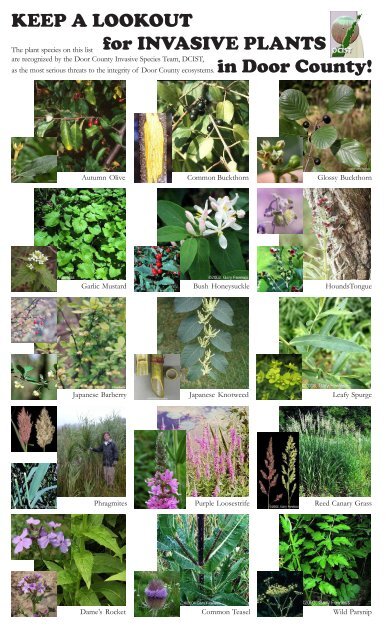KEEP A LOOKOUT for INVASIVE PLANTS in Door County!
KEEP A LOOKOUT for INVASIVE PLANTS in Door County!
KEEP A LOOKOUT for INVASIVE PLANTS in Door County!
Create successful ePaper yourself
Turn your PDF publications into a flip-book with our unique Google optimized e-Paper software.
<strong>KEEP</strong> A <strong>LOOKOUT</strong><br />
<strong>for</strong> <strong>INVASIVE</strong> <strong>PLANTS</strong><br />
<strong>in</strong> <strong>Door</strong> <strong>County</strong>!<br />
The plant species on this list<br />
are recognized by the <strong>Door</strong> <strong>County</strong> Invasive Species Team, DCIST,<br />
as the most serious threats to the <strong>in</strong>tegrity of <strong>Door</strong> <strong>County</strong> ecosystems.<br />
Autumn Olive Common Buckthorn<br />
Garlic Mustard<br />
Glossy Buckthorn<br />
HoundsTongue<br />
Japanese Barberry Japanese Knotweed Leafy Spurge<br />
Phragmites<br />
Dame’s Rocket<br />
Bush Honeysuckle<br />
Purple Loosestrife<br />
Common Teasel<br />
Reed Canary Grass<br />
Wild Parsnip
Help tackle these <strong>INVASIVE</strong> <strong>PLANTS</strong> <strong>in</strong> <strong>Door</strong> <strong>County</strong>!<br />
IF you recognize any of these plants, TAKE ACTION!<br />
1. Report the sight<strong>in</strong>g to:<br />
http://map.co.door.wi.us/swcd/<strong>in</strong>vasive/InvasiveForm.htm<br />
2. Contact DCIST <strong>for</strong> further <strong>in</strong><strong>for</strong>mation and management options.<br />
By phone: 920-746-5955 or email: dcist1@gmail.com<br />
3. Spread the word to friends, neighbors and community members!<br />
AUTUMN OLIVE (Elaeagnus<br />
umbellata) This large shrub can<br />
reach heights of 20’, with ovalshaped<br />
1’ to 3’ leaves. Leaves<br />
and twigs have coppery/silvery<br />
scales. It produces small p<strong>in</strong>k to<br />
red fruits late <strong>in</strong> the season.<br />
GARLIC MUSTARD (Alliaria<br />
petiolata) This cool-season,<br />
biennial herb grows 12’ - 40”<br />
tall, has triangular shaped<br />
leaves with toothed edges and<br />
smells of garlic when crushed.<br />
It has clusters of small flowers<br />
with 4 petals. First year plants<br />
are low rosettes with rounded<br />
leaves.<br />
JAPANESE BARBERRY<br />
(Berberis thunbergii) This lowgrow<strong>in</strong>g<br />
shrub grows to a<br />
height of 2’ to 3’. Leaves are<br />
small, oval to spoon shaped that<br />
cluster <strong>in</strong> tight bunches above<br />
sp<strong>in</strong>es. Flowers are small <strong>in</strong><br />
clusters of 2 -4 and bloom <strong>in</strong><br />
May. Fruits are bright red,<br />
egg-shaped berries.<br />
COMMON BUCKTHORN<br />
(Rhamnus cathartica) This<br />
shrub can reach 20’ tall and<br />
have dark bark with silvery<br />
marks called lenticels. Leaves<br />
are dull, green toothed-edged<br />
and female plants have dark<br />
fruits <strong>in</strong> fall and w<strong>in</strong>ter.<br />
BUSH HONEYSUCKLE<br />
(Lonicera sp.) This large shrub<br />
can reach heights of 18’. It has<br />
oblong or oval leaves which are<br />
slightly hairy underneath. Flowers<br />
bloom <strong>in</strong> June. They are<br />
abundant and p<strong>in</strong>k which fade to<br />
yellow as they age. The bark is<br />
gray and shaggy with hollow older<br />
branches.<br />
JAPANESE KNOTWEED<br />
(Polygonum cuspidatum) This<br />
herbaceous perennial has hollow,<br />
bamboo-like stems, heartshaped<br />
leaves and greenishwhite<br />
flowers. It <strong>for</strong>ms large<br />
clones that range <strong>in</strong> height from<br />
4’ to 10’ and can cover several<br />
acres. It spreads vegetatively<br />
through long rhizomes.<br />
GLOSSY BUCKTHORN<br />
(Rhamnus frangula) This<br />
shrub can reach 20’ tall and<br />
have dark bark with silvery<br />
marks called lenticels. Leaves<br />
are untoothed and sh<strong>in</strong>y on top.<br />
Fruits ripen from red to dark<br />
purple <strong>in</strong> July to September.<br />
HOUND’S TONGUE<br />
(Cynoglossum offic<strong>in</strong>ale) This<br />
tall biennial plant has unbranched<br />
stems and large<br />
tongue shaped leaves. Flowers<br />
bloom <strong>in</strong> clusters <strong>in</strong> June<br />
and July and are red to purple<br />
<strong>in</strong> color.<br />
LEAFY SPURGE<br />
(Euphorbia esula) This perennial<br />
has stems 6” to 36”<br />
tall, with bluish-green leaves<br />
and yellow-green flowers. It<br />
has a milky white sap that can<br />
cause rashes or <strong>in</strong>flammation<br />
of the sk<strong>in</strong>.<br />
PHRAGMITES (Phragmites PURPLE LOOSESTRIFE REED CANARY GRASS<br />
australis) This perennial reed (Lythrum salicaria) This wet- (Phalaris arund<strong>in</strong>acea) This<br />
grass, with gray-green leaves, land plant grow 2’ to 7’ tall. large course grass reaches 2’ to<br />
is found most often <strong>in</strong> large Stem is stiff and usually 4-sided 6’ <strong>in</strong> height. The stem is hair-<br />
colonies, rang<strong>in</strong>g <strong>in</strong> height from or rounded. Leaves are<br />
less with taper<strong>in</strong>g leaf blades 3”<br />
6’ to 13’. It has a large light- whorled, flat with smooth edges. to 10” long. Flower<strong>in</strong>g occurs<br />
brown to purple flower spike Flowers have 5 or 6 rose- <strong>in</strong> May to mid-June, flowers<br />
that appears between July and purple petals that <strong>for</strong>m a spike appear purple to green at first<br />
September.<br />
bloom<strong>in</strong>g from bottom to top of<br />
the spike.<br />
then change to beige.<br />
DAME’S ROCKET (Hesperis COMMON TEASEL<br />
WILD PARSNIP (Past<strong>in</strong>aca<br />
matronalis) This showy,<br />
(Dipsacus fullonum sylvestris) sativa) Rosette has 6” to 18”<br />
short-lived perennial has a This perennial grows as a basal compound leaves until it<br />
large, loose clusters of fra-<br />
rosette <strong>for</strong> one year be<strong>for</strong>e flowers. Flower stalks grow<br />
grant white, p<strong>in</strong>k or purple 4- grow<strong>in</strong>g a stem and flower<strong>in</strong>g. about 4’ and have umbrellapetaled<br />
flowers that bloom Flowers bloom June through like clusters of yellow flowers<br />
from May- to July on 2’ to 3’ October and are p<strong>in</strong>k or purple that from large flat seeds.<br />
stalks.<br />
<strong>in</strong> color. Leaves are simple, Flowers <strong>for</strong> 2-5 years then<br />
prickly and oblong.<br />
dies. CAUTION: Causes<br />
pa<strong>in</strong>ful burn<strong>in</strong>g of sk<strong>in</strong>.<br />
More <strong>in</strong><strong>for</strong>mation can be found at:<br />
www.dnr.state.wi.us/<strong>in</strong>vasives www.ipaw.org www.mipn.org<br />
Photo Credits: Gary Fewless, S. Kelly Kearns, Kenneth Stysma, Elizabeth Czarapata, Emmet J. Judziewicz, Robert W. Freckmann,<br />
Kurt Stüber, Dennis W. Woodland, www.floracyberia.net, University of Wiscons<strong>in</strong> - Steven’s Po<strong>in</strong>t, Wiscons<strong>in</strong> DNR website, Michigan<br />
State University extension website. Taxonmy Credits: Wiscons<strong>in</strong> DNR website and Wild Cards, Invasive Plants of the Upper<br />
Midwest by Elizabeth Czarapata, Wildflowers of Wiscons<strong>in</strong> and the Upper Midwest by Merel R. Black and Emmet J. Judziewicz





![A Guide to the Control and Management of Invasive Phragmites [PDF]](https://img.yumpu.com/19126786/1/190x190/a-guide-to-the-control-and-management-of-invasive-phragmites-pdf.jpg?quality=85)





![Homeowner's Guide to Japanese Knotweed Control [PDF]](https://img.yumpu.com/19126766/1/190x245/homeowners-guide-to-japanese-knotweed-control-pdf.jpg?quality=85)




